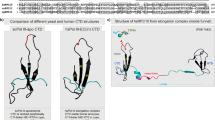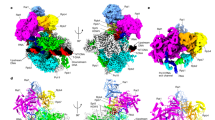Abstract
At the 3′ ends of protein-coding genes, RNA polymerase (Pol) II is dephosphorylated at tyrosine residues (Tyr1) of its C-terminal domain (CTD). In addition, the associated cleavage-and-polyadenylation factor (CPF) cleaves the transcript and adds a poly(a) tail. Whether these events are coordinated and how they lead to transcription termination remains poorly understood. Here we show that CPF from Saccharomyces cerevisiae is a Pol II–CTD phosphatase and that the CPF subunit Glc7 dephosphorylates Tyr1 in vitro. In vivo, the activity of Glc7 is required for normal Tyr1 dephosphorylation at the polyadenylation site, for recruitment of termination factors Pcf11 and Rtt103 and for normal Pol II termination. These results show that transcription termination involves Tyr1 dephosphorylation of the CTD and indicate that pre-mRNA processing by CPF and transcription termination are coupled via Glc7-dependent Pol II–Tyr1 dephosphorylation.
This is a preview of subscription content, access via your institution
Access options
Subscribe to this journal
Receive 12 print issues and online access
$189.00 per year
only $15.75 per issue
Buy this article
- Purchase on Springer Link
- Instant access to full article PDF
Prices may be subject to local taxes which are calculated during checkout




Similar content being viewed by others
Accession codes
References
Brannan, K. & Bentley, D.L. Control of transcriptional elongation by RNA Polymerase II: a retrospective. Genet. Res. Int. 2012, 170–173 (2012).
Buratowski, S. Progression through the RNA polymerase II CTD cycle. Mol. Cell 36, 541–546 (2009).
Corden, J.L. Transcription: seven ups the code. Science 318, 1735–1736 (2007).
Jeronimo, C., Bataille, A.R. & Robert, F. The writers, readers, and functions of the RNA Polymerase II C-terminal domain code. Chem. Rev. 113, 8491–8522 (2013).
Komarnitsky, P., Cho, E.J. & Buratowski, S. Different phosphorylated forms of RNA polymerase II and associated mRNA processing factors during transcription. Genes Dev. 14, 2452–2460 (2000).
Schroeder, S.C., Schwer, B., Shuman, S. & Bentley, D. Dynamic association of capping enzymes with transcribing RNA polymerase II. Genes Dev. 14, 2435–2440 (2000).
Ahn, S.H., Kim, M. & Buratowski, S. Phosphorylation of serine 2 within the RNA polymerase II C-terminal domain couples transcription and 3′ end processing. Mol. Cell 13, 67–76 (2004).
Mayer, A. et al. CTD tyrosine phosphorylation impairs termination factor recruitment to RNA polymerase II. Science 336, 1723–1725 (2012).
Niño, C.A., Hérissant, L., Babour, A. & Dargemont, C. mRNA nuclear export in yeast. Chem. Rev. 113, 8523–8545 (2013).
Garneau, N.L., Wilusz, J. & Wilusz, C.J. The highways and byways of mRNA decay. Nat. Rev. Mol. Cell Biol. 8, 113–126 (2007).
Kapp, L.D. & Lorsch, J.R. The molecular mechanics of eukaryotic translation. Annu. Rev. Biochem. 73, 657–704 (2004).
Zhao, J., Hyman, L. & Moore, C. Formation of mRNA 3′ ends in eukaryotes: mechanism, regulation, and interrelationships with other steps in mRNA synthesis. Microbiol. Mol. Biol. Rev. 63, 405–445 (1999).
Mandel, C.R., Bai, Y. & Tong, L. Protein factors in pre-mRNA 3′-end processing. Cell Mol. Life Sci. 65, 1099–1122 (2008).
McCracken, S. et al. The C-terminal domain of RNA polymerase II couples mRNA processing to transcription. Nature 385, 357–361 (1997).
Licatalosi, D.D. et al. Functional interaction of yeast pre-mRNA 3′ end processing factors with RNA polymerase II. Mol. Cell 9, 1101–1111 (2002).
Hirose, Y. & Manley, J.L. RNA polymerase II is an essential mRNA polyadenylation factor. Nature 395, 93–96 (1998).
Proudfoot, N.J. Ending the message: poly(a) signals then and now. Genes Dev. 25, 1770–1782 (2011).
Birse, C.E., Minvielle-Sebastia, L., Lee, B.A. & Keller, W. Coupling termination of transcription to messenger RNA maturation in yeast. Science 280, 298–301 (1998).
Barillà, D., Lee, B.A. & Proudfoot, N.J. Cleavage/polyadenylation factor IA associates with the carboxyl-terminal domain of RNA polymerase II in Saccharomyces cerevisiae. Proc. Natl. Acad. Sci. USA 98, 445–450 (2001).
Sadowski, M., Dichtl, B., Hübner, W. & Keller, W. Independent functions of yeast Pcf11p in pre-mRNA 3′ end processing and in transcription termination. EMBO J. 22, 2167–2177 (2003).
Meinhart, A. & Cramer, P. Recognition of RNA polymerase II carboxy-terminal domain by 3′-RNA-processing factors. Nature 430, 223–226 (2004).
Krishnamurthy, S., He, X., Reyes-Reyes, M., Moore, C. & Hampsey, M. Ssu72 is an RNA polymerase II CTD phosphatase. Mol. Cell 14, 387–394 (2004).
Meinhart, A., Silberzahn, T. & Cramer, P. The mRNA transcription/processing factor Ssu72 is a potential tyrosine phosphatase. J. Biol. Chem. 278, 15917–15921 (2003).
Nedea, E. et al. Organization and function of APT, a subcomplex of the yeast cleavage and polyadenylation factor involved in the formation of mRNA and small nucleolar RNA 3′-ends. J. Biol. Chem. 278, 33000–33010 (2003).
Bataille, A.R. et al. A universal RNA polymerase II CTD cycle is orchestrated by complex interplays between kinase, phosphatase, and isomerase enzymes along genes. Mol. Cell 45, 158–170 (2012).
Xiang, K. et al. Crystal structure of the human symplekin-Ssu72-CTD phosphopeptide complex. Nature 467, 729–733 (2010).
Nedea, E. et al. The Glc7 phosphatase subunit of the cleavage and polyadenylation factor is essential for transcription termination on snoRNA genes. Mol. Cell 29, 577–587 (2008).
Gilbert, W. & Guthrie, C. The Glc7p nuclear phosphatase promotes mRNA export by facilitating association of Mex67p with mRNA. Mol. Cell 13, 201–212 (2004).
He, X. & Moore, C. Regulation of yeast mRNA 3′ end processing by phosphorylation. Mol. Cell 19, 619–629 (2005).
Shi, Y. Serine/threonine phosphatases: mechanism through structure. Cell 139, 468–484 (2009).
Chu, Y., Lee, E.Y. & Schlender, K.K. Activation of protein phosphatase 1: formation of a metalloenzyme. J. Biol. Chem. 271, 2574–2577 (1996).
Egloff, M.P., Cohen, P.T., Reinemer, P. & Barford, D. Crystal structure of the catalytic subunit of human protein phosphatase 1 and its complex with tungstate. J. Mol. Biol. 254, 942–959 (1995).
Haruki, H., Nishikawa, J. & Laemmli, U.K. The anchor-away technique: rapid, conditional establishment of yeast mutant phenotypes. Mol. Cell 31, 925–932 (2008).
Mayer, A. et al. Uniform transitions of the general RNA polymerase II transcription complex. Nat. Struct. Mol. Biol. 17, 1272–1278 (2010).
Cho, E.J., Kobor, M.S., Kim, M., Greenblatt, J. & Buratowski, S. Opposing effects of Ctk1 kinase and Fcp1 phosphatase at Ser 2 of the RNA polymerase II C-terminal domain. Genes Dev. 15, 3319–3329 (2001).
Peti, W., Nairn, A.C. & Page, R. Structural basis for protein phosphatase 1 regulation and specificity. FEBS J. 280, 596–611 (2013).
MacKintosh, C. et al. Further evidence that inhibitor-2 acts like a chaperone to fold PP1 into its native conformation. FEBS Lett. 397, 235–238 (1996).
Farkas, I., Dombrádi, V., Miskei, M., Szabados, L. & Koncz, C. Arabidopsis PPP family of serine/threonine phosphatases. Trends Plant Sci. 12, 169–176 (2007).
Kim, T.-W. et al. Brassinosteroid signal transduction from cell-surface receptor kinases to nuclear transcription factors. Nat. Cell Biol. 11, 1254–1260 (2009).
Chao, Y. et al. Structure and mechanism of the phosphotyrosyl phosphatase activator. Mol. Cell 23, 535–546 (2006).
Kim, M. et al. The yeast Rat1 exonuclease promotes transcription termination by RNA polymerase II. Nature 432, 517–522 (2004).
Logan, J., Falck-Pedersen, E., Darnell, J.E. & Shenk, T. A poly(a) addition site and a downstream termination region are required for efficient cessation of transcription by RNA polymerase II in the mouse βmaj-globin gene. Proc. Natl. Acad. Sci. USA 84, 8306–8310 (1987).
Mischo, H.E. & Proudfoot, N.J. Disengaging polymerase: terminating RNA polymerase II transcription in budding yeast. Biochim. Biophys. Acta 1829, 174–185 (2013).
Passmore, L.A. et al. Doc1 mediates the activity of the anaphase-promoting complex by contributing to substrate recognition. EMBO J. 22, 786–796 (2003).
Sydow, J.F. et al. Structural basis of transcription: mismatch-specific fidelity mechanisms and paused RNA polymerase II with frayed RNA. Mol. Cell 34, 710–721 (2009).
Chapman, R.D. et al. Transcribing RNA polymerase II is phosphorylated at CTD residue serine-7. Science 318, 1780–1782 (2007).
Mayer, A. et al. The spt5 C-terminal region recruits yeast 3′ RNA cleavage factor I. Mol. Cell Biol. 32, 1321–1331 (2012).
Nagalakshmi, U. et al. The transcriptional landscape of the yeast genome defined by RNA sequencing. Science 320, 1344–1349 (2008).
Acknowledgements
We thank A. Cheung (Cramer laboratory), N.A. Yewdall (Passmore laboratory) and the mass spectrometry facility at the MRC Laboratory of Molecular Biology (LMB) for help, D. Barford for discussions, E. Kremmer and D. Eick (Helmholtz Zentrum München) for antibodies and S. Munro (MRC-LMB) for yeast strains. A.D.E. was supported by a Woolf Fisher Trust Scholarship, and K.W. was supported by a fellowship from the Deutsche Forschungsgemeinschaft. Work in the lab of L.A.P. is supported by MRC grant MC_U105192715 (L.A.P.) and European Research Council (ERC) Starting Grant 261151 (L.A.P.). P.C. was supported by the Deutsche Forschungsgemeinschaft (SFB646, SFB960, SFB1064, CIPSM, NIM, QBM), an ERC Advanced Grant, the Jung-Stiftung and the Vallee Foundation.
Author information
Authors and Affiliations
Contributions
A.S., A.D.E., S.E. and K.W. performed experiments. M.L. analyzed data. L.A.P. and P.C. designed and supervised research. A.S., A.D.E., L.A.P. and P.C. wrote the manuscript.
Corresponding authors
Ethics declarations
Competing interests
The authors declare no competing financial interests.
Integrated supplementary information
Supplementary Figure 1 Growth analysis and fluorescence microscopy of anchor-away yeast strains.
(a) Serial dilutions of wild-type and Glc7 and Ssu72 anchor-away yeast strains plated on YPD (left panel) and YPD + rapamycin (right panel) show that rapamycin is lethal for the anchor-away strains but it has no effect on wild-type growth. FRB, FKBP12-rapamycin-binding. (b) Fluorescence microscopy of fixed cells of the Ssu72-FRB/Glc7-mCherry strain shows that Glc7 is located in both cytoplasm and nucleus (left panel). This distribution does not change when rapamycin is added to the cells (lower panel). DAPI stain is shown as a control (right panel).
Supplementary Figure 2 Depletion of Glc7 from the nucleus leads to a defect in Tyr1-P dephosphorylation.
ChIP-chip occupancy profile of Tyr1-phosphorylated Pol II over 619 genes without and with rapamycin (solid and dotted line, respectively; see Fig. 2a for normalized profiles). The profiles include the region from 250 nucleotides upstream of the transcription start site (TSS) to 400 nucleotides downstream of the polyadenylation site (pA).
Supplementary Figure 3 Genome-wide ChIP occupancy of Tyr1-phosphorylated Pol II around the pA site is not influenced by rapamycin in wild-type yeast.
ChIP-chip occupancy profiling of Tyr1-phosphorylated Pol II over 619 genes aligned at the pA site (dashed line) and normalized against the corresponding Rpb3 profile without and with rapamycin (violet line and violet dotted line, respectively). The profile in a region from 400 nucleotides upstream to 400 nucleotides downstream of the polyA site is shown.
Supplementary information
Supplementary Text and Figures
Supplementary Figures 1–4 (PDF 2473 kb)
Rights and permissions
About this article
Cite this article
Schreieck, A., Easter, A., Etzold, S. et al. RNA polymerase II termination involves C-terminal-domain tyrosine dephosphorylation by CPF subunit Glc7. Nat Struct Mol Biol 21, 175–179 (2014). https://doi.org/10.1038/nsmb.2753
Received:
Accepted:
Published:
Issue Date:
DOI: https://doi.org/10.1038/nsmb.2753
This article is cited by
-
The PNUTS-PP1 complex acts as an intrinsic barrier to herpesvirus KSHV gene expression and replication
Nature Communications (2022)
-
CDK9 keeps RNA polymerase II on track
Cellular and Molecular Life Sciences (2021)
-
Distinct Cdk9-phosphatase switches act at the beginning and end of elongation by RNA polymerase II
Nature Communications (2020)
-
RNA polymerase II phosphorylation and gene looping: new roles for the Rpb4/7 heterodimer in regulating gene expression
Current Genetics (2020)
-
A Cdk9–PP1 switch regulates the elongation–termination transition of RNA polymerase II
Nature (2018)



